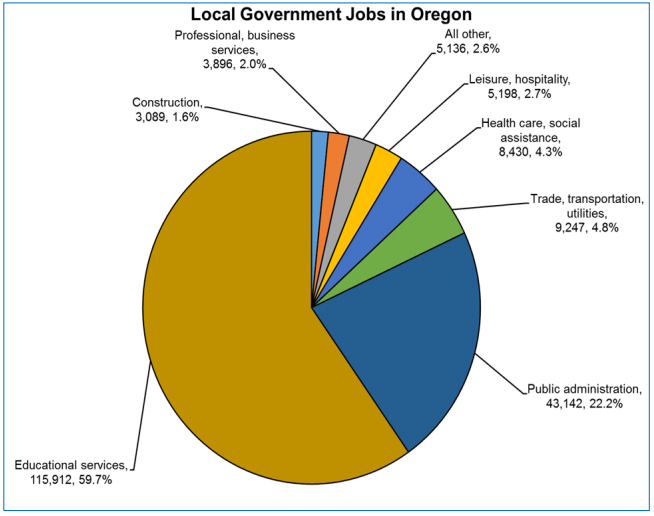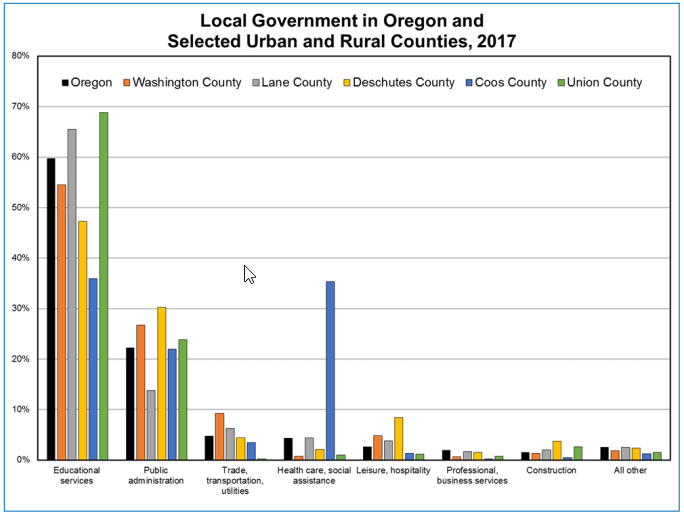The Diversity of Local Government in Oregon
Conversations about government employment are typically very opinionated – regardless of who is talking, the specific focus of the conversation, and where the discussion takes place! No matter which side of the fence people may be on, a county-level analysis of government employment offers insights for any discussion.

“To Promote the General Welfare” The role of government services is traditionally rooted in the concept that individual communities cannot provide all the basic goods or services that residents need. In other words, some needs are extensive or expensive enough that it takes a coordinated approach to address them. Specific areas of local government responsibility include education, public health, safety (police and fire protection), transportation services, public works (streets, sewers, waste disposal, and snow removal), economic planning, and building and maintaining such recreational features as libraries, parks, athletic fields, and community centers. In Oregon, local government includes city and county governments as well as special districts (e.g., ports, transit systems, and regional governments that are multi-jurisdictional councils). Adding to this broad range of services are constituent-created, special service districts designed to meet local needs for water control, irrigation, hospitals, people’s utilities, and vector control.
Scrutinizing Oregon’s Largest Local Government Sectors
Nearly 60 percent of Oregon’s local government employment falls within the educational services sector. This includes publicly supported elementary and secondary schools as well as community colleges and institutions of higher education. Elementary and secondary schools account for 59 percent of statewide education employment and pay an average annual wage of $44,403. Oregon’s statewide colleges and universities employ nearly 29 percent of those associated with educational services ($70,353) and community or junior colleges account for 11 percent of employment ($36,851). Other educational services make up the remaining positions.
Public administration, more than one out of five jobs, is the arena that most people associate with local government, e.g., city and county management, police and corrections, etc. The average salary, $62,961, ranges from those working in executive and legislative bodies ($58,996) to police ($84,493) and fire ($83,703) protection. However, many communities rely on volunteer fire personnel to handle local fire protection services. Public administration is divided into two smaller sectors. Executive, legislative, and general government makes up 51.2 percent of public administration employment. Justice, public order, and safety-related employment constitutes 28.9 percent of jobs. Under the heading of justice and related activities, police protection makes up one out of three jobs; correctional institutions account for 16.8 percent; and fire protection makes up 34.1 percent. Other smaller duties involving legal counsel and parole offices account for the rest.
Other business activities in local government have a smaller footprint than education services and public administration. Trade, transportation, and utilities employment is in transportation, warehousing, and utilities ($57,613). Transit/ground passenger transport constitutes 55.5 percent of this sector ($44,523) and utilities accounts for 33.7 percent ($71,012). Health care and social assistance accounts for 4.3 percent of Oregon’s local government employment; leisure and hospitality is 2.7 percent; and professional and business services, of which two-thirds is in administration and waste services, accounts for 2.0 percent. Other activities such as libraries, repair and maintenance, cemeteries, and data processing-related services round out the remaining positions.

Oregon’s Diversity in Local Government
Employment Approximately 75 percent of Oregon’s total employment hugs the I-5 corridor from the Portland area south into Eugene’s Lane County. When venturing away from the north-south interstate highway, it is not surprising to see the focus of local government employment change to meet the needs of smaller, rural communities.
Public education is the largest component of local government in Oregon (59.7%). The presence of large, higher education institutions substantially increases the footprint of educational services in select Oregon counties. Eastern Oregon University in Union County – some 260 miles east of the Portland Metro corridor – contributes nearly 70 percent to the county’s local government employment. In Lane County, 110 miles south of Portland and home to the University of Oregon, educational services make up 65.5 percent of the local government presence. At first glance, Washington County appears to have a substantially large educational component to its local government sector. However, Oregon Health Sciences University (OHSU), which shows up as a large educational presence, has more jobs in health-related positions than in education (two out of three jobs).
Eastern Oregon, some Gorge communities, and southwestern Oregon are all home to special health care districts. Oregon legislation (ORS 440.320) enables those in sparsely populated regions to create special health care service districts. Employment in these districts falls under the auspices of local government. As a result, Coos County’s three special health care districts shift the county’s health care-related employment to local government, meaning 35 percent of local government jobs are associated with providing health services.
Conclusion
Overall, in Oregon, government makes up 15.2 percent of all payroll employment. Local government constitutes seven out of 10 government jobs; state government covers two out of 10; and federal government employment accounts for one out of 10 government jobs in the state. Rural areas have a larger government presence – one out of four payroll jobs in Coos and Union counties are in government. Although the distribution among federal, state, and local government varies depending on the county, local government dominates the public employment arena. The services provided, and the close accountability to local constituents, enable each part of Oregon to maintain its unique character while providing publicly supported educational, health care, public administrative, and other necessary services.

Small Business Advocate, Office of the Secretary of State
Ruth works collaboratively with small businesses, nonprofits, state and local government to help streamline and improve Oregon’s business climate. She brings a unique combination of public and private sector experience to her work in the Secretary’s Office of Small Business Assistance. With 18 years of experience running small businesses, Ruth understands first-hand the challenges that entrepreneurs face. An avid kayaker, she comes to the Secretary of State after nine years in the legislative branch, where she helped constituents navigate the shifting waters and complexities of state government.
https://sos.oregon.gov/business/Documents/business -guides/start-business-guide.pdf
The office of the Secretary of State is where you will find Ruth Miles. After meeting with her on several occasions it is evident her support of, and advocacy for, business in Oregon is her calling. She travels all over the state appearing at economic development meetings, speaking to small business owners and entrepreneurs eager to assist in any way she is able.
The team of people working with Ruth is an asset to us all. Be sure to have their contact information readily available. If they don’t have an answer for you, they will find someone who does.
– Greg Henderson, Publisher, Southern Oregon Business Journal


Advertisement